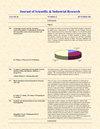Deep Neural Network Based Modelling of Chemisorption Process on Surface of Oxide Based Gas Sensors
IF 0.8
4区 工程技术
Q3 ENGINEERING, MULTIDISCIPLINARY
引用次数: 0
Abstract
The sensor response of the metal oxide based gas sensor has been simulated using Deep Neural Network (DNN) model. The neural network designed for the modelling of the sensor has single input layer, three hidden layers and single output layer. The linear regression algorithm has been used to compute the electrical conductance of the sensor at given temperature and pressure. The data generated through modified Wolkenstein method has been used for training, validation and testing of the developed network. The data for materials Tin (IV) oxide (SnO2), Tin (II) oxide (SnO) and Copper (I) oxide (Cu2O) with different Eg values has been utilized. The other input parameters like Temperature, ND, NC, NV, EF−ESSand ECS−EF are varied for the specific range to collect a variety of data for calculation of electrical conductance of the sensor. The total data used for training, validation and testing was 1,90,512 data points. The plots for training, validation and testing phase have been plotted. The sensor response computed through the proposed model is validated with the results of already published mathematical model. The sensor response shows steep change when the gas concentration of the target gas reaches above 10−8 atm. The proposed model can be retrained or transfer learning can be applied for using the same model for other types of materials for gas sensing applications.基于深度神经网络的氧化基气体传感器表面化学吸附过程建模
利用深度神经网络(DNN)模型对金属氧化物气体传感器的传感器响应进行了仿真。用于传感器建模的神经网络具有单输入层、三隐藏层和单输出层。用线性回归算法计算了给定温度和压力下传感器的电导。通过改进的Wolkenstein方法生成的数据已用于开发的网络的训练,验证和测试。利用了不同Eg值的氧化锡(SnO2)、氧化锡(SnO)和氧化铜(Cu2O)材料的数据。其他输入参数,如温度、ND、NC、NV、EF−ess和ECS−EF在特定范围内变化,以收集各种数据,用于计算传感器的电导。用于训练、验证和测试的总数据为1,90,512个数据点。绘制了训练、验证和测试阶段的图。通过该模型计算的传感器响应与已发表的数学模型的结果进行了验证。当目标气体浓度达到10 ~ 8 atm以上时,传感器响应发生了急剧变化。所提出的模型可以重新训练或迁移学习可以应用于使用相同的模型用于气体传感应用的其他类型的材料。
本文章由计算机程序翻译,如有差异,请以英文原文为准。
求助全文
约1分钟内获得全文
求助全文
来源期刊

Journal of Scientific & Industrial Research
工程技术-工程:综合
CiteScore
1.70
自引率
16.70%
发文量
99
审稿时长
4-8 weeks
期刊介绍:
This oldest journal of NISCAIR (started in 1942) carries comprehensive reviews in different fields of science & technology (S&T), including industry, original articles, short communications and case studies, on various facets of industrial development, industrial research, technology management, technology forecasting, instrumentation and analytical techniques, specially of direct relevance to industrial entrepreneurs, debates on key industrial issues, editorials/technical commentaries, reports on S&T conferences, extensive book reviews and various industry related announcements.It covers all facets of industrial development.
 求助内容:
求助内容: 应助结果提醒方式:
应助结果提醒方式:


